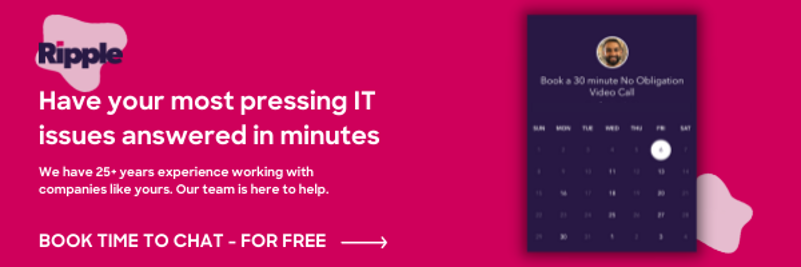
Like any relationship, deciding to end things with your managed service provider (MSP) can trigger many emotions. You've had good times—and bad!—but you can't face the fact that it's finally over.
You might want to break up with your MSP for many reasons—ongoing technical issues, communication fails, and perhaps a cybersecurity lapse or two. But once you decide to make the switch, you can find a new provider that treats you like a valued customer.
Learn more about how to switch MSPs below.
Signs It's Time to Dump Your MSP
At least 60% of organizations will depend on a managed service provider by 2025 as business owners look for new ways to optimize their IT operations and efficiencies. But sometimes, relationships with these third-party firms don't go as expected, with MSPs impeding productivity or not meeting their service-level agreements. Other times, an MSP might fail to go the distance to protect you against cybersecurity threats.
Here are five reasons why you might need to split with your MSP:
- Service Breakdowns: Your MSP struggles to meet agreed-upon response times or service objectives, leading to ongoing IT issues or even major outages.
- Communication Failures or Inadequate Support: It's difficult to reach your account manager or MSP's help desk, making you doubt their claims that you're a valued customer. It certainly doesn't feel that way!
- Cybersecurity Issues: You chose your MSP to avoid, not increase, cybersecurity events. Still, your provider doesn't protect you against bad actors, system failures, and data loss.
- Lack of Innovation: If your MSP doesn't keep up with the changing needs of your IT operations, things can go south pretty quickly. A good provider should support, not hinder, your overall business goals.
- Non-Transparent Billing: You should know what you're paying your MSP for. However, things can get complicated if your provider doesn't explain service costs or charges you hidden fees you weren't expecting.
Sometimes, there's nothing wrong with your MSP per se, but you've simply outgrown it. Your organizational goals no longer align with their capabilities, causing you to look elsewhere for a provider that ticks all your boxes.

Does Your MSP Have Your Back?
Over 2,200 cybersecurity attacks occur every day—that's one every 39 seconds or so. Working with an MSP should provide some peace of mind in an ever-changing IT landscape. But if you're experiencing recurring technical issues, it could be time to terminate your relationship with your current MSP.
Technical issues that cause you to switch MSPs might include:
- Failed backups
- Server crashes, leading to unplanned downtime
- Data loss/breaches
- Inadequate monitoring or non-existent insights into your IT infrastructure
If IT problems keep happening, you might jeopardize your company's reputation or lose customers. Another MSP will provide you with peace of mind and bolster your brand's reliability.
Taking an evaluative approach when deciding to work with a new MSP is a good call. You'll want to assess your current provider's alignment with your company's growth and technology needs and look elsewhere if things aren't working out.
How to End Things With Your MSP
It's best to be honest with your provider from the offset. Skirting around issues or hoping things improve will only delay your inevitable breakup. Here are some steps to take before canceling your contract:
- Understand the repercussions of ending your relationship. For example, you might need to pay a fee to get out of your contract early.
- Tell your MSP that you’re ending your contract and be specific when you explain the reasons you're parting ways. Understanding why things didn’t work out can help you know what to look for in your next MSP.
- Tell your MSP that you’re transitioning to a different provider and start the offboarding process with your new MSP. Your current company will need to work closely with your new one for a more seamless switchover.
Your new MSP should take care of the rest during their offboarding process. For example, they can help you return any hardware you've borrowed from your existing MSP, such as routers and networking gear.

Final Thoughts About How to Switch MSPs
There are many signs that it may be time to switch to a new IT MSP. However, you'll want things to go as smoothly as possible when switching from one provider to another. To avoid future complications, be more specific with your new partner about your current goals, long-term objectives, and preferred MSP best practices.
Then, come up with a transition plan that reduces business disruption during your switchover. For instance, define responsibilities and roles for your IT team and negotiate contract terms with your future provider to protect your business interests and ensure a successful partnership.
If you're looking to switch to a new MSP, make sure it's an MSP that your team members won't mind calling, that proactively aligns your IT with your business goals, and that makes sure your IT is set up so your people can do their best work. Learn more about how Ripple might be the perfect fit for you. Schedule a consultation with Melissa to learn more.
FAQs
Here are answers to some commonly asked questions about switching MSPs:
What are the signs you should break up with your current MSP?
Non-transparent billing, a lack of innovation, cybersecurity fails, breakdowns in service, and poor communication are just some reasons to end your MSP relationship. Ultimately, if you're unhappy with the service you receive, consider working with a different provider. Sometimes, it's just that simple.
How do recurring technical issues indicate a need to switch MSPs?
If you experience server crashes, unplanned downtime, failed backups, data loss, and other problems, you might want to shop around for a more reliable MSP.
What steps should you take before breaking up with your MSP?
Communicate with your provider about why you're ending your contract. Then, return any hardware and pay off your final invoice. Maintaining good relations with your current MSP will ensure a more seamless transition to your new one.
How can you ensure a smooth transition to a new MSP?
Tell your future provider about your expectations, current goals, and long-term objectives to ensure you get more value from your new MSP. Work closely and collaboratively with your IT team, your old MSP, and your new MSP to follow your transition plan.
Don't Fall Behind!
Get the latest work-from-home and Humans First® IT tips straight to your inbox.
